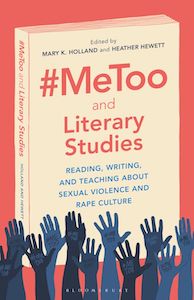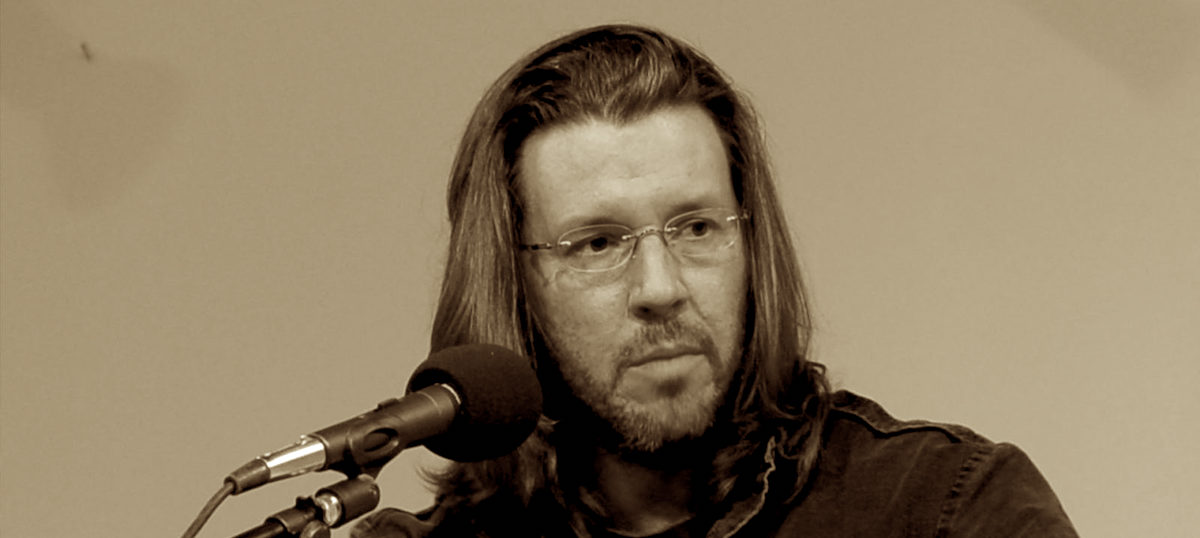Feature photo by Steve Rhodes.
David Foster Wallace’s work has long been celebrated for audaciously reorienting fiction toward empathy, sincerity, and human connection after decades of (supposedly) bleak postmodern assertions that all had become nearly impossible. Linguistically rich and structurally innovative, his work is also thematically compelling, mounting brilliant critiques of liberal humanism’s masked oppressions, the soul-killing dangers of technology and American narcissism, and the increasing impotence of our culture of irony.
Wallace spoke and wrote movingly about our need to cultivate self-awareness in order to more fully see and respect others, and created formal methods that construct the reader-writer relationship with such piercing intimacy that his fans and critics feel they know and love him. A year after his death by suicide, as popular and critical attention to him and his work began to build into the industry of Wallace studies that exists today, he was first outed as a misogynist who stalked, manipulated, and physically attacked women.
In her 2009 memoir, Lit, Mary Karr spends less than four pages narrating the several years in which Wallace pursued her, leading to a brief romantic relationship that ended in vicious arguments and “his pitching my coffee table at me.” Unlike her accounts of the relationship nearly a decade later, Karr’s tone here notably remains clever and humorous throughout. She also follows each disclosure of Wallace’s ferocity with a confession of her own regrettable behavior: regarding his “temper fits” she admits to “sentences I had to apologize for” and assures us—twice—that “no doubt he was richly provoked.” After describing the coffee-table incident, she notes parenthetically that “years later, we’ll accept each other’s longhand apologies for the whole debacle,” as if having a piece of furniture thrown at you makes you as guilty as having thrown it.
Three years later D.T. Max published his biography of Wallace, in which he divulged more shocking details about the relationship with Karr—that Wallace tried to buy a gun to kill her husband, that he tried to push her from a moving car—while also dropping enough details about Wallace’s sex life and professed attitudes toward women to make him sound like one of his own hideous men. Wallace called female fans at his readings “audience pussy”; wondered to Jonathan Franzen whether “his only purpose on earth was ‘to put my penis in as many vaginas as possible’”; picked up vulnerable women in his recovery groups; admitted to a “fetish for conquering young mothers,” like Orin in Infinite Jest; and “affected not to care that some of the women were his students.”
In a 2016 anthology dedicated to the late author, one of those students, Suzanne Scanlon, published a short story about a student having a manipulative, emotionally abusive sexual affair with her professor (called “D-,” “Author,” and “a self-identified Misogynist”), using characteristic formal elements of “Octet” and “Brief Interviews” and dominated by the narrative voice popularized by David Foster Wallace.
None of these accounts had any visible impact on fans’ or readers’ love of Wallace’s writing or on critics’ readings and opinions of his work. Rather, one writer, Rebecca Rothfeld, confessed in 2013 that Max’s record of (some of) Wallace’s misogynistic acts and statements could not shake her “faith in [his] fundamental goodness, intelligence, and likeability” because his “work seemed more real to me than his behavior did.” Critic Amy Hungerford took the opposite stance in 2016, proclaiming her decision to stop reading and teaching Wallace’s work, but without mentioning his abusive treatment of women or the question of how that behavior presses us to re-read the same in his work.
Another writer, Deirdre Coyle, explained her discomfort at reading Wallace not in terms of the author’s own behavior—which she gives no sign of being aware of—but because of sexual and misogynistic violence perpetrated on her by men she sees as very much like Wallace (“Small liberal arts colleges are breeding grounds for these guys”) and in terms of patriarchy in general (“It’s hard to distinguish my reaction to Wallace from my reaction to patriarchy.” Any woman who has been violated, talked over, and condescended to by this kind of man, the kind who thinks his pseudo-feminism allows him to enlighten her about her own experiences of male oppression and sexual violation, cannot help but sympathize with Coyle.
But in rejecting Wallace because of other men’s sexual violence and misogyny in general, she shifts the argument away from questions about how these function in the fiction and how Wallace’s biography might force us to re-read that fiction, and allows for the kind of circular rebuttal that a (male) Wallace critic offered a year later: not all male readers of Wallace are misogynists; therefore, women should listen to the good ones and read more Wallace; let me tell you why.
#MeToo also began to make the misogyny of Wallace’s work more visible to his readers.These pre-#MeToo reactions to Karr’s and Max’s reports of Wallace’s abuse of women clarify what is at stake as readers, critics, and teachers consider this biographical information in the context of Wallace’s work. For, while Wimsatt and Beardsley’s argument against the intentional fallacy is compelling and important, its goal is to protect the sanctity of the text against the undue influence of our assumptions about the person who wrote it. Arguments defending the importance of Wallace’s beautiful empathizing fiction in spite of his abuse of women threaten to do the opposite.
Like Rothfeld, whose admiration for Wallace’s fiction renders his own misogynistic acts less “real,” David Hering argues that “the biographical revelation of unsavoury details about Wallace’s own relationships” leads to an equation between Wallace and misogyny that “does a fundamental disservice to the kind of urgent questions Wallace asks in his work about communication, empathy, and power”—as if Wallace’s real abuse of real women is not worth contemplating in comparison with his writing about how fictional men treat fictional women. Hering’s use of the euphemism “unsavoury” to describe behavior ranging from exploitation to physical attacks, like his description of Wallace’s work regarding gender as “troublesome,” illustrates another widespread problem with nearly all critical treatments of this topic so far: an unwillingness to say, or perhaps even see, that what we are talking about in the fiction and in the author’s life is gender-motivated violence, stalking, physical abuse, even, in the case of Karr’s husband, plotting to murder.
In the wake of the October 2017 resurgence of Burke’s #MeToo movement, we see a curious split between Wallace-studies critics and others in their reactions to these allegations. Not only does Hering’s response downplay the severity of Wallace’s behavior and its relevance to his work; it also asserts Hering’s “belief” that Wallace’s work “dramatize[s]” misogyny, rather than expressing it—without offering a text-based argument or pointing to the critical work that had already done this analysis and found exactly the opposite to be true.
He also relies on a technique used by memoirists, bloggers, and critics alike in their attempts to save Wallace from his own biography: he converts an example of male domination of women into a universal human dilemma, erasing the elements of gender and power entirely, by reading Wallace’s silencing of his female interviewer’s voice in Brief Interviews as “embody[ing] the richness of Wallace’s work—its focus on the difficulty and importance of communication and empathy, and its illustration of the poisonous things that happen when dialogue breaks down.” Such a reading ignores the fact that when dialogue breaks down between an entitled man and a pressured woman, the things that can happen go beyond metaphorically poisonous to physically sickening and injurious—as so many of the stories in that collection illustrate.
Given the same platform and the same task—celebrating Wallace around what would have been his 56th birthday—critic Clare Hayes-Brady offered “Reading David Foster Wallace in 2018,” mere months after the social media flood of women’s testimonies about sexual violence had begun. It does not mention #MeToo or the public allegations that had been made about Wallace, raising the question of what “in 2018” refers to. When asked several months later “what’s changed?” in Wallace studies, after the public (but not critical) backlash had begun, Hayes-Brady falls back on the same generalizing technique used by Hering. She reframes accusations of misogyny as an entirely academic development, beneficial to Wallace studies and unrelated to #MeToo outcry against perpetrators of sexual violence (“a coincidence of timing”). She equates “flaws in his writing both technical and also moral and ethical,” as if women had been up in arms across Twitter over Wallace’s exhausting sentence structures.
When directly asked if Wallace was a misogynist, she replies “yes, but in the way everyone is, including me,” as if we neither have nor need a separate word for men who do not just live unavoidably in our misogynistic culture but also willfully perpetrate selfish, cruel, and violent acts of misogyny against women. That is, rather than responding humanely to indisputable evidence that our beloved writer was not the saint he would have liked us to think he was (and that we would have liked to believe him to be), Wallace critics—including me, in my silence at that time—refused to allow #MeToo to force the reckoning that was so clearly required. We did so by denying the relevance of his personal behavior to his fiction and to our work, or—worse—by participating in that age-old rape culture enabler: refusing to believe women’s testimony.
Those outside literary studies reacted quite differently to the renewed attention #MeToo brought to these accusations. After Junot Díaz was publicly accused on May 4, 2018, of sexually abusing women, causing immediate public protest, Mary Karr responded by reminding us on Twitter of the abuse she had reported nearly a decade earlier, prompting a series of blog articles and interviews that supported Karr by recounting the allegations made by Karr and Max. They also began to reveal the misogyny that had shaped and stifled public reception of those allegations.
What does it mean that this artist could not produce in his life the mutually respecting empathy he all but preached in his work (or, most clearly, in his statements about it)?Whitney Kimball pointed out that Max described Wallace’s violent treatment of Karr as beneficial to his creative output and part of what made him “fascinating”; that in praising the “quite remarkable” “craftsmanship” of one of Wallace’s letters, Max notes only in passing that the letter is Wallace’s apology for planning to buy a gun to kill Karr’s husband. Megan Garber noted the misogyny of an interviewer asking Max why “his feelings for [Karr] created such trouble for Wallace”—an example of what Kate Manne calls “himpathy,” or empathizing with a male perpetrator of sexual violence rather than the victim.
#MeToo also began to make the misogyny of Wallace’s work more visible to his readers. Devon Price describes how reading about Wallace’s abuses against women caused them to revisit Wallace’s work and see its gender violence for the first time. Tellingly, Price also realizes that one of the reasons they were depressed when they fell in love with Wallace’s work is that they were then in a physically, emotionally, and sexually abusive relationship. Price’s realization points to another common reason why readers are blind to or defensive about the misogyny in Wallace’s work and behavior, and to a key way in which the #MeToo movement can allow reading and literary studies to illuminate misogyny in synergistic ways: we are often blind to misogyny and sexual abuse, in fiction and in others’ behavior, because we are living in it unaware. And the awareness of the spectrum of sexual abuse brought by #MeToo testimonies reveals misogyny not just in the fiction that we read, but in our own lives—one revelation causing the other.
To date, no new criticism has emerged that directly considers the implications to his work of Wallace’s now widely reported misogyny and violence toward women. But the recent publication of Adrienne Miller’s memoir In the Land of Men (2020), which describes her years-long relationship with Wallace while she was literary editor at Esquire, makes a compelling, if unwitting, argument for the necessity of such biographically informed criticism. Miller documents the connection between Wallace’s life and work in excruciating detail, recounting extended scenes between them in which Wallace speaks and acts nearly identically to the misogynists of Brief Interviews, an identification he encourages by telling her that “some of the interviews were ‘actual conversations I had when I had to break up with people.’”
But though Miller lays out the “sexism” of Wallace’s fiction, especially Jest and Brief Interviews, more baldly than any of us Wallace scholars has so far, she remains, even from the vantage point of twenty years later and post-#MeToo, unable or unwilling to identify Wallace’s treatment of her as abusive or misogynistic. In fact, most shocking about the memoir is not its record of Wallace’s behavior but its methodical and steadfast refusal to acknowledge the gender violence of that behavior, and Miller’s disturbing pattern of normalizing, apologizing for, and denying it.
Ultimately, she attempts to redirect us from the question of whether her relationship with Wallace qualifies as abuse or sexual harassment by asking, “Who looks to the artist’s life for moral guidance anyway?” and “What are we to do with the art of profoundly compromised men?” But rather than neatly pivoting from Wallace’s culpability, these questions reveal important reasons why we must consider the lives of such men in conversation with their art. For these men are not merely passively “compromised” but aggressively compromising, in ways that our misogynistic culture obscures, and which savvy investigation of their art and lives can illuminate. And “moral” investigation is particularly indicated by the work of Wallace, who declared himself a maverick writer willing to return literature to earnestness and “love” (“Interview with David Foster Wallace” 1993), who wrote fiction that quizzes us on ethics and human value (“Octet” 1999), and who delivered a beloved commencement speech arguing the importance of recognizing one’s inherent narcissism in order to extend care to others.
What does it mean that this artist could not produce in his life the mutually respecting empathy he all but preached in his work (or, most clearly, in his statements about it)? What does it mean that a man and a body of work that claimed feminism in theory primarily produced a stream of abusive relationships between men and women in life and art? What can we learn about the blindness of both men and women to their participation in misogyny and rape culture, despite their professions of awareness of both? How might reading Wallace’s fiction in the contexts of biographical information about him and women’s narratives about their experiences of sexual violence enable us to better understand—and interrupt—the powerful hold misogyny and rape culture have on our society, our art, and our critical practices?
_____________________________________________________________________

Excerpted from #MeToo and Literary Studies: Reading, Writing, and Teaching about Sexual Violence and Rape Culture, edited by Mary K. Holland & Heather Hewett. Reprinted with permission of the publisher, Bloomsbury Academic. © 2021 by Mary K. Holland & Heather Hewett.



